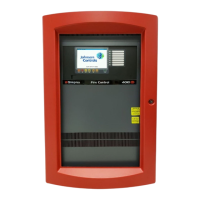page 63 579-1150 Rev M
4010ES IDNAC Fire Alarm System Installation Guide
9 System wiring checkout and earth fault diagnostics
This chapter describes how to check system wiring and run the Earth Fault Diagnostics in the panel.
9.1 Checking system wiring
This section contains instructions on how to use a multimeter to check system wiring.
When using the multimeter to check each circuit, make sure to adhere to the notes and instructions below.
Note:
• Ensure that no power is applied to the 4010ES fire alarm panel and that all wiring is properly connected (terminal blocks, LED/switch
module ribbon cables, etc.)
• Use the grounding lug with the earth ground symbol inside the control panel for all measurements to ground.
• Each circuit must test free of all grounds and extraneous (stray) voltages.
• If there are problems removing all power from the fire alarm system, there is an alternate method of testing for stray voltage. The
wires may be lifted from the panel and terminated with appropriate resistors. Use 3.3 KOhms across conductor pairs and 50 KOhms
connected from any conductor under test to ground. All conductors must read less than 1.0 VAC or VDC.
Use a multimeter as described in the steps below to check each circuit type.
1. At the control panel, locate wires from each initiating device or indicating appliance
circuit.
2. Check each circuit for extraneous voltage by setting the volt/ohm meter to AC. Place the meter probes so that the black probe is
on the “-” wire and the red probe is on the “+” wire. Meter readings must show less than 1.0 VAC.
3. Set the multimeter to DC and repeat step 2. The meter must read less than 1.0 VDC.
4. Check all conductors for extraneous voltage to ground. The meter must read less than 1.0 VAC and VDC.
5. Set the multimeter to OHMS and place the meter probes as described in step 2. Check the circuits using the resistance
measurements in Table 34. Locate and correct any abnormal conditions at this time.
Note: If the reading indicates an open circuit in an initiating circuit, make sure the smoke detector heads are properly mounted
and seated. The circuit may be open if smoke detector power is not present, and if separately powered 4-wire devices are used.
6. Check all other system wiring to verify that each circuit is free of grounds and extraneous voltages.
9.1.1 Meter readings
Table 34 lists the correct meter readings for indicating appliances and initiating devices.
Table 34: Acceptable zone and signal circuit meter readings
Circuit type Meter reading
Class B Initiating Device (Zone) Circuit
From zone + to zone – (each zone) 3.3KOhms
From zone + to ground Infinity
From zone - to ground Infinity
Class A Initiating Device (Zone) Circuit
From zone + to zone – (each zone) Infinity
From zone + to ground Infinity
From zone - to ground Infinity
From zone + OUT to + IN Less than 25Ohms
From zone - OUT to - IN Less than 25Ohms
Class B Notification Appliance Circuit (each signal circuit)
From + to ground Infinity
From - to ground Infinity
Class A Notification Appliance Circuit (each signal circuit)
From + to ground Infinity
From - to ground Infinity
From B+ to A+ Less than 15Ohms
From B- to A- Less than 15Ohms
IDNET+ Loops (ZAMs and IAMs)
From IDNET+ “+” to ground Infinity
From IDNET+ “-” to ground Infinity
Note: Ground refers to earth ground.

